TA2047 - Urban Hornsea
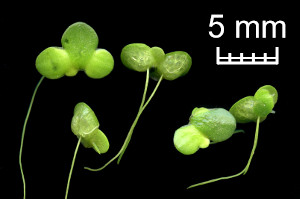 Much of Hornsea is situated within this single kilometre square but only about half is built-up, the remainder being public open space offering several different habitats each contributing taxa to a remarkable total of 240. We followed Atlas 2020 instruction to record long-established planted trees in open spaces and discounting these and surprisingly few garden escapes, the total is still outstanding.
Much of Hornsea is situated within this single kilometre square but only about half is built-up, the remainder being public open space offering several different habitats each contributing taxa to a remarkable total of 240. We followed Atlas 2020 instruction to record long-established planted trees in open spaces and discounting these and surprisingly few garden escapes, the total is still outstanding.The most productive site was the infrequently mown cemetery where curbed grave areas provided small gardens for an amazing variety of ruderal species of which Veronica agrestis was perhaps the most notable. Stream Dike was appallingly eutrophic but yielded up Lemna gibba [photo above - RM] admixed with L. trisulca. Deeper in the murk there was Myriophyllum spicatum with emergent Bolboschoenus maritimus nearby. A small marshy area with shallow pools behind the boat compound produced more L. gibba with L. minor and both Juncus bufonius and J. articulatus. At the low, moat end of Garth Park, marshy grassland yielded up both Glyceria declinata and G. fluitans, and Alopecurus geniculatus.
We took a back street between parallel cobble walls, the North-facing of which yielded up our local 'standard six' wall ferns and the grass
We lamented the absence of Gabrielle 'hawkeye' Jarvis who would have pushed our total higher had she not been stuck on a bus!
Peter J Cook, October 18 2017
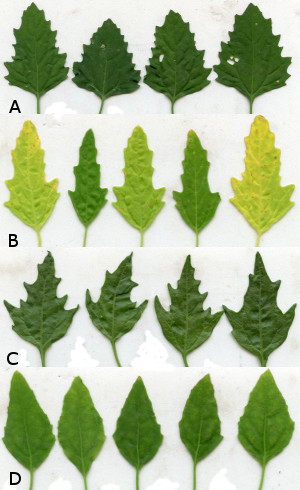 A couple of weeks ago I was pleased to receive a list of vc61 plant records from Dr Katherine Glover. Among some very interesting and useful records was one which instantly grabbed my attention for several reasons. This was for Chenopodium ficifolium (Fig-leaved Goosefoot) growing on the demolished Ings Estate near Saltshouse Road, east Hull. It is a taxon that I do not recall having ever seen, would not be able to identify without reference to Stace and our only post-2000 record was from Cedric Gillings of a plant at Gristhorpe, only metres from the vc's northen boundary. Worse than that I had once lived, for 25 years, within a couple of hundred metres of the place.
A couple of weeks ago I was pleased to receive a list of vc61 plant records from Dr Katherine Glover. Among some very interesting and useful records was one which instantly grabbed my attention for several reasons. This was for Chenopodium ficifolium (Fig-leaved Goosefoot) growing on the demolished Ings Estate near Saltshouse Road, east Hull. It is a taxon that I do not recall having ever seen, would not be able to identify without reference to Stace and our only post-2000 record was from Cedric Gillings of a plant at Gristhorpe, only metres from the vc's northen boundary. Worse than that I had once lived, for 25 years, within a couple of hundred metres of the place.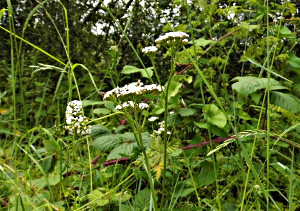 Credit for this find should be accorded to the late Mr Frank Kennington who, several years ago, reported seeing a, "queer-looking big yarrow near Welwick Saltmarsh". At that time I found plants that were not exceptionally bigger than yarrow, but certainly had paler green leaves like those of tansy in outline, but were more finely dissected. We agreed that it is probably just a 'sport' of yarrow and I thought no more about it until today, 1 July 2017. Looking through our Atlas 2020 progress maps I noted Achillea distans listed with only one record of the taxon, on West Hull Dock, 1938 (Ref Crackles' flora). I looked for descriptions and images of A. distans on the internet and realised that the Welwick plant is, indeed, A. distans. I took camera and Stace and re-found it scattered among sea couch and bramble along the track from Sheep-Trod lane to Welwick Saltmarsh reserve entrance at TA338191, over a distance of about 500 m. The tallest plant was 1.2 metre high but most were in the range 50 to 80 cm.
Credit for this find should be accorded to the late Mr Frank Kennington who, several years ago, reported seeing a, "queer-looking big yarrow near Welwick Saltmarsh". At that time I found plants that were not exceptionally bigger than yarrow, but certainly had paler green leaves like those of tansy in outline, but were more finely dissected. We agreed that it is probably just a 'sport' of yarrow and I thought no more about it until today, 1 July 2017. Looking through our Atlas 2020 progress maps I noted Achillea distans listed with only one record of the taxon, on West Hull Dock, 1938 (Ref Crackles' flora). I looked for descriptions and images of A. distans on the internet and realised that the Welwick plant is, indeed, A. distans. I took camera and Stace and re-found it scattered among sea couch and bramble along the track from Sheep-Trod lane to Welwick Saltmarsh reserve entrance at TA338191, over a distance of about 500 m. The tallest plant was 1.2 metre high but most were in the range 50 to 80 cm.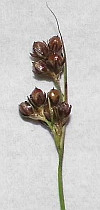 Extra special care has to be taken over differentiating Juncus compressus growing in a brackish habitat from J. gerardii. Several different texts were used to examine specimens of suspected J. compressus found on sandy mud bordering recently (3-5 years) excavated scrapes in the slack of the grey dunes behind Welwick Saltmarsh at TA 337191.
Extra special care has to be taken over differentiating Juncus compressus growing in a brackish habitat from J. gerardii. Several different texts were used to examine specimens of suspected J. compressus found on sandy mud bordering recently (3-5 years) excavated scrapes in the slack of the grey dunes behind Welwick Saltmarsh at TA 337191.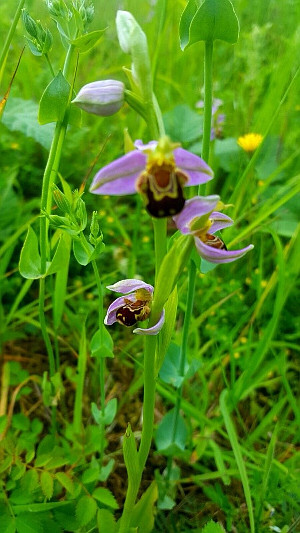 My son, Matthew, spotted a colony (swarm?) of bee orchids on private land in Keyingham, TA22, and took this photograph with his mobile phone. Unknown to him was the significance of the perfoliate plant adjacent to it. Yellow-wort, Blackstonia perfoliata, is always worth looking for near bee orchids - and vice versa - as they seem to be inseparable bed partners.
My son, Matthew, spotted a colony (swarm?) of bee orchids on private land in Keyingham, TA22, and took this photograph with his mobile phone. Unknown to him was the significance of the perfoliate plant adjacent to it. Yellow-wort, Blackstonia perfoliata, is always worth looking for near bee orchids - and vice versa - as they seem to be inseparable bed partners.
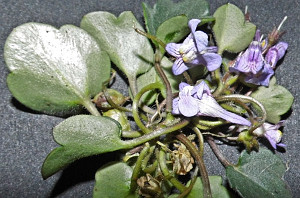
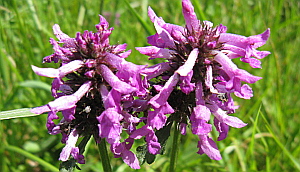 The BSBI Local Group meeting at Wayrham turned out to be a rather low-key event with our numbers severely depleted by member's work and holiday commitments. Never-the-less Gabrielle and I managed to make a decent impression on tetrads I and P. Our efforts were augmented with lists for Fordeham Dale made the previous (very wet) day by Gabrielle and John K.
The BSBI Local Group meeting at Wayrham turned out to be a rather low-key event with our numbers severely depleted by member's work and holiday commitments. Never-the-less Gabrielle and I managed to make a decent impression on tetrads I and P. Our efforts were augmented with lists for Fordeham Dale made the previous (very wet) day by Gabrielle and John K.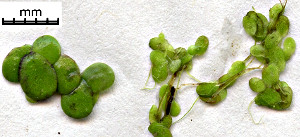 It is always worth looking closely at Duckweeds. The alien Lemna minuta (Least Duckweed) seems to be becoming rather common and widespread within the county and has probably been under-recorded. The above image shows a couple of fronds of Lemna minor from my garden pond (left) and a sample of Lemna minuta from a pond at Eastrington (right). At Eastrington the alien duckweed was completely covering the surface of a heavily shaded, lowland pond but only a week or so before I had seen it covering the surface of an exposed Wolds "dew pond" at Fordon. The small size of the fronds - generally arround 2mm - is characteristic.
It is always worth looking closely at Duckweeds. The alien Lemna minuta (Least Duckweed) seems to be becoming rather common and widespread within the county and has probably been under-recorded. The above image shows a couple of fronds of Lemna minor from my garden pond (left) and a sample of Lemna minuta from a pond at Eastrington (right). At Eastrington the alien duckweed was completely covering the surface of a heavily shaded, lowland pond but only a week or so before I had seen it covering the surface of an exposed Wolds "dew pond" at Fordon. The small size of the fronds - generally arround 2mm - is characteristic.
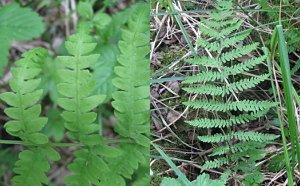 Our Local Group was pleased to have Mr Chris McGregor of Natural England accompany us on our visit to this Hull Headwaters SSSI making a total of nine persons. The marsh is sallow and alder carr on the floodplain of the river Hull and tributary chalk streams to the west of Sunderlandwick. It is a site that has had infrequent detailed botanical surveys, the last one being a National Vegetation mapping exercise six years ago, which included only cursory notes of notable field layer species. Within seconds of setting foot into an area recently cleared of sallow, we found tussocks of sedge. Historically there has been dispute as to the identity of tussock sedges at Kelleythorpe and this continues! We decided to refer to expert opinion and moved on.
Our Local Group was pleased to have Mr Chris McGregor of Natural England accompany us on our visit to this Hull Headwaters SSSI making a total of nine persons. The marsh is sallow and alder carr on the floodplain of the river Hull and tributary chalk streams to the west of Sunderlandwick. It is a site that has had infrequent detailed botanical surveys, the last one being a National Vegetation mapping exercise six years ago, which included only cursory notes of notable field layer species. Within seconds of setting foot into an area recently cleared of sallow, we found tussocks of sedge. Historically there has been dispute as to the identity of tussock sedges at Kelleythorpe and this continues! We decided to refer to expert opinion and moved on. 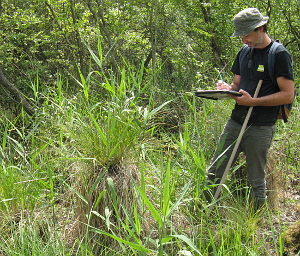
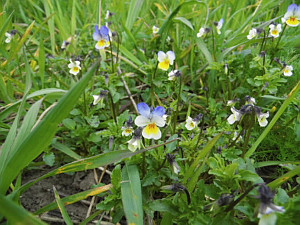 This tetrad is on the western outer limit of vc61 and is one of the last remaining target tetrads in a hectad predominantly within the adjacent Vice County and occupied largely by the City of York. It has a wide range of broad habitats including standing and flowing fresh water, marsh and rush mire bordering rides through coniferous woodland, arable fields and mixed species hedgerow. Bracken and Rhododendron understorey covered extensive areas of Hagg Wood in the eastern half. Highlights of the day included monoecious Nitella flexilis, our first stonewort record at Local Group meetings. A fallow arable field was notable for both Viola tricolor and V. arvensis with numerous sizes and colour combinations. The terrestrial form of Bulbous Rush Juncus bulbosus with its neat circular tufts; Bog Stitchwort Stellaria uliginosa with its elastic stele; violets prompting differentiation between V. riviniana vs. reichenbachiana vs. odorata; a horsetail emergent from water 'behaving badly' for both Equisetum palustre and E. fluviatile and leaves of Leopard's-bane Doronicum pardalianches each resulted in 'diagnostic huddles', and proved necessity to carry vegetative keys at least in Spring.
This tetrad is on the western outer limit of vc61 and is one of the last remaining target tetrads in a hectad predominantly within the adjacent Vice County and occupied largely by the City of York. It has a wide range of broad habitats including standing and flowing fresh water, marsh and rush mire bordering rides through coniferous woodland, arable fields and mixed species hedgerow. Bracken and Rhododendron understorey covered extensive areas of Hagg Wood in the eastern half. Highlights of the day included monoecious Nitella flexilis, our first stonewort record at Local Group meetings. A fallow arable field was notable for both Viola tricolor and V. arvensis with numerous sizes and colour combinations. The terrestrial form of Bulbous Rush Juncus bulbosus with its neat circular tufts; Bog Stitchwort Stellaria uliginosa with its elastic stele; violets prompting differentiation between V. riviniana vs. reichenbachiana vs. odorata; a horsetail emergent from water 'behaving badly' for both Equisetum palustre and E. fluviatile and leaves of Leopard's-bane Doronicum pardalianches each resulted in 'diagnostic huddles', and proved necessity to carry vegetative keys at least in Spring.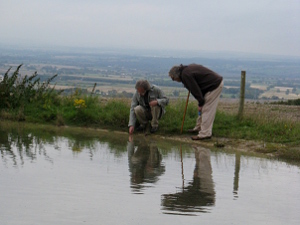 On this our last planned Local Group outing we were blessed with dry, warm weather and a good selection of broad habitats including arable and conifer plantation margins; the well-trampled path of the Wolds Way on chalk; chalk banks including unimproved grass sward on ancient earthworks; hedgerows and a chalk stream. An artist's interpretation of goodness-knows-what with a sky-mirror dewpond yielded only one decent record - Chara vulgaris var. vulgaris - and provided lessons on which species sown out of context can survive on an exposed chalk hilltop at 150 m. Well done Phacelia and Daucus.
On this our last planned Local Group outing we were blessed with dry, warm weather and a good selection of broad habitats including arable and conifer plantation margins; the well-trampled path of the Wolds Way on chalk; chalk banks including unimproved grass sward on ancient earthworks; hedgerows and a chalk stream. An artist's interpretation of goodness-knows-what with a sky-mirror dewpond yielded only one decent record - Chara vulgaris var. vulgaris - and provided lessons on which species sown out of context can survive on an exposed chalk hilltop at 150 m. Well done Phacelia and Daucus.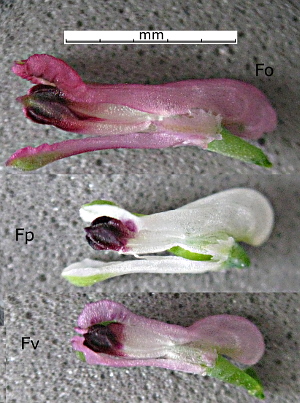 In June 2011 Cedric Gilling found plants of Fumaria vaillantii (Few-flowered Fumitory) growing in set-aside at Fordon. It was associated with F. officinalis (Common Fumitory) and the Nationally and Regionally scarce F. parviflora (Fine-leaved Fumitory). At the time its identity was confirmed by Rosemary Murphy, the BSBI referee and Handbook author, and it became vc61's only record of Britain's rarest Fumitory. A recent visit to Fordon by the combined might of the Hull Natural History Society, Ryedale Natural History Society and the YNU Botany Section provided an opportunity to check on the taxon's survival. Having never seen the plant before I adopted a "shotgun" approach and collected representative samples from the spectrum of Fumitories growing in what is now a sparse rape field, with the hope of bagging a "vaillantii".
In June 2011 Cedric Gilling found plants of Fumaria vaillantii (Few-flowered Fumitory) growing in set-aside at Fordon. It was associated with F. officinalis (Common Fumitory) and the Nationally and Regionally scarce F. parviflora (Fine-leaved Fumitory). At the time its identity was confirmed by Rosemary Murphy, the BSBI referee and Handbook author, and it became vc61's only record of Britain's rarest Fumitory. A recent visit to Fordon by the combined might of the Hull Natural History Society, Ryedale Natural History Society and the YNU Botany Section provided an opportunity to check on the taxon's survival. Having never seen the plant before I adopted a "shotgun" approach and collected representative samples from the spectrum of Fumitories growing in what is now a sparse rape field, with the hope of bagging a "vaillantii".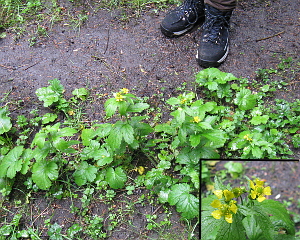 After one of the driest Aprils on record and an equally arid start to May, we were treated to a restoration of nature's fluid balance. Despite the rain, four stalwarts (?) proceeded with the planned exploration of Wheldrake Wood in steadily deteriorating weather and although the conditions were not conducive to overt enthusiasm we did enjoy several hours of interesting botany; John's knowledge of forestry trees bumping up our list of conifers considerably. With the exception of some Marsh Orchids and a couple of plants of a steroid-fuelled Geum (provisionally identified as G. macrophyllum, see picture), we didn't find anything particularly exotic but with a total of over 130 taxa we were well satisfied with our expedition.
After one of the driest Aprils on record and an equally arid start to May, we were treated to a restoration of nature's fluid balance. Despite the rain, four stalwarts (?) proceeded with the planned exploration of Wheldrake Wood in steadily deteriorating weather and although the conditions were not conducive to overt enthusiasm we did enjoy several hours of interesting botany; John's knowledge of forestry trees bumping up our list of conifers considerably. With the exception of some Marsh Orchids and a couple of plants of a steroid-fuelled Geum (provisionally identified as G. macrophyllum, see picture), we didn't find anything particularly exotic but with a total of over 130 taxa we were well satisfied with our expedition.
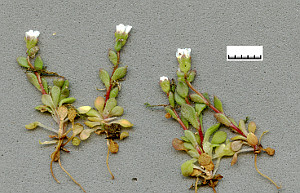 Yellow may normally be considered the colour of Spring but for the urban botanist it is certainly white. The pavement cracks and corners are now full of small white-flowered plants which can look remarkably similar from a distance - Bittercresses, Thale Cress, Whitlowgrass, Scurvygrass, Shepherd's-purse, etc. Yesterday morning I encountered a dense patch of such plants on the corner of Charlotte Street and Grimston Street, Hull. Very closely crowded and low-growing I did not recognise them immediately so took a small specimen in the hope of Cerastium semidecandrum. Careful examination at home revealed fleshy spathulate leaves,a dense covering of red-tipped hairs and short blunt sepals - Saxifraga tridactylites. (picture - mm scale)
Yellow may normally be considered the colour of Spring but for the urban botanist it is certainly white. The pavement cracks and corners are now full of small white-flowered plants which can look remarkably similar from a distance - Bittercresses, Thale Cress, Whitlowgrass, Scurvygrass, Shepherd's-purse, etc. Yesterday morning I encountered a dense patch of such plants on the corner of Charlotte Street and Grimston Street, Hull. Very closely crowded and low-growing I did not recognise them immediately so took a small specimen in the hope of Cerastium semidecandrum. Careful examination at home revealed fleshy spathulate leaves,a dense covering of red-tipped hairs and short blunt sepals - Saxifraga tridactylites. (picture - mm scale)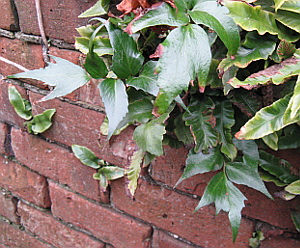 John Killingbeck and Gabrielle Jarvis have made an interesting discovery in Hornsea this month - Cyrtomium falcatum (House Holly-fern) growing with Asplenium scolopendrium (Hart's-tongue) on a shady wall. It would be very easy to overlook this alien fern which is a relatively recent addition to our vice-county's flora.
John Killingbeck and Gabrielle Jarvis have made an interesting discovery in Hornsea this month - Cyrtomium falcatum (House Holly-fern) growing with Asplenium scolopendrium (Hart's-tongue) on a shady wall. It would be very easy to overlook this alien fern which is a relatively recent addition to our vice-county's flora.